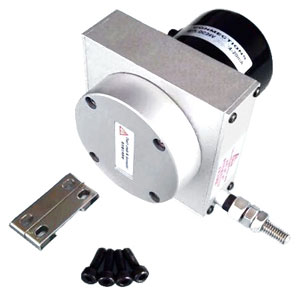Tips for Using Draw-wire Displacement Sensor
Draw-wire Displacement Sensor Features
The draw-wire displacement sensor could transfer the mechanical displacement into measurable and linearly proportional electric signal. When the measured object has a displacement, the sensor wire connected to it will be pulled to drive the sensor's transmission mechanism and encoder to rotate synchronously. When the displacement moves backwards, the automatic gyratory device inside the sensor will automatically retrieve the wire while keeping a constant tension during this process, and then the sensor outputs an electrical signal proportional to the wire movement. The sensor has an independent automatic winding mechanism, which ensures the automatic and even arranging of the pulling wire and ensures a high precision and long service life of the sensor.
Draw-wire Displacement Sensor Application
The ATO 1000-50000mm draw-wire displacement sensor has a small mounting size, compact structure and high precision. Its measuring range can be 1000mm/2500mm/5000mm or even 50000mm. This draw-wire displacement sensor is particularly suitable for linear rolling guide system, hydraulic cylinder system, testing machine, telescopic system (forklift, press, lifter, pipe bender, bending machine, etc), crane or cable winch, reservoir dam protection system, gate opening control system, pressure machine, hydraulic universal experimental machinery, warehouse location position, length and displacement measurement and position control of various industrial instruments.
Attentions on ATO Draw-wire Displacement Sensor
Here, there are 7 tips for you to have a better experience of using our 1000-50000mm draw-wire displacement sensor.

- With the four fixed screw holes on the bottom, the sensor can be installed directly or with additional protection mechanism according to the situation and installation space.
- When installing the stainless steel cable, pay attention to the horizontal angle, that means to slide the cable horizontally from the outlet to the target position while keeping a min angle (allowable deviation +/-30), so as to ensure the measurement accuracy and cable life.
- The cable is made of stainless steel with fluoride coating, please keep it from being cut, burned or impacted by external force. Excessive dust, debris or other material residues in the pulley interior or outlet will cause cable damage, result in poor operation.
- Do not pull the cable out by hand or other objects to bounce it back before completing the installation, so as to prevent the cable from breaking, destroying the product structure and personal safety.
- It is suggested that the instantaneous acceleration of the cables at reciprocating motion should not exceed 0.5 m/s when using the product, otherwise the cable may break.
- If applied to non-linear motion machinery, pulleys should be properly installed.
- If applied in harsh environment or special occasions, protection mechanism should be installed or negotiate with product supplier, otherwise product damage may occur.

